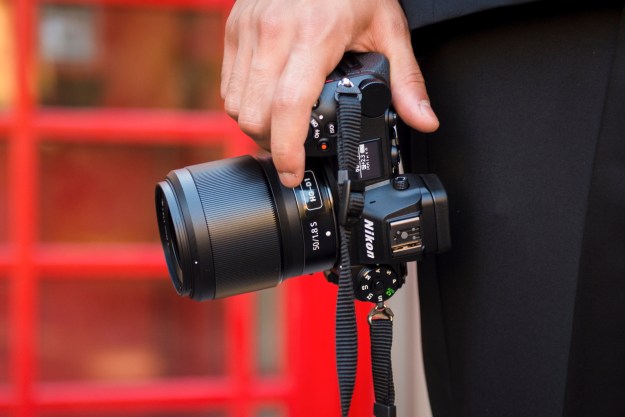- 12-megapixel image sensor; wide-angle lens; easy-to-read LCD; great picture quality
- Limited manual adjustments; no HD video; objectionable noise at ISO 1600 and higher
Summary
Panasonic’s Lumix DMC-FS15 is a very good mid-priced point-and-shoot camera that’s particularly strong at taking close-ups. The unit’s small, relatively thin, and light enough to carry in a shirt pocket, but it’s loaded with features including a 12 megapixel image sensor and a Leica 28-145mm lens. The DMC-FS15 has a few shortcomings, including bothersome digital noise in shots taken at the far end of its ISO range and a zoom lens that tops out at 5X optical, but such limitations are to be expected from a camera with a street price well below $200.

The Lumix DMC-FS15’s dimensions put it squarely in the subcompact class. It measures 3.82 inches wide by 2.14 inches high by 0.85 inches deep, and it weighs 4.87 ounces with its battery and an SD memory card installed. (The camera accepts both SD and higher-capacity SD-HC media).
There’s not much to see on the front of the camera. There’s the lens, the auto-focus assist lamp (which also acts as a self-timer indicator), and the flash unit. With the camera in auto mode, you don’t need to push any buttons to enable the flash. Overriding the flash to shoot in natural light takes just three button presses on the back of the camera.

The 2.7-inch LCD viewfinder occupies most of the space on the back of the camera, with an array of buttons to the right of it. The slider that switches between record and playback mode feels rather sloppy, but the other buttons feel substantial and provide solid tactile feedback and an audible tone (which can be disabled) when pressed. The oval Mode button calls up a menu with the camera’s five basic modes: Intelligent Auto, Normal Picture, Film Grain, Scene Mode, and Motion Pictures.

Information presented on the LCD was easy to read, even in direct sunlight and at extreme angles. Viewing subjects in front of the lens and examining photos stored on the memory card while outdoors, however, was more difficult because they have much less contrast.
What’s Included
The Lumix DMC-FS15 comes with a Lithium-ion battery, a plug-in battery charger, a hand-strap, and USB data and A/V cables. There’s also a CD-ROM containing several software programs (Panasonic’s own PhotoFunStudio 3.0 software, Apple’s QuickTime movie player, and ArcSoft’s Panorama Maker 4 and MediaImpression), and a 119-page user manual. The camera comes with 50MB of onboard storage, but that’s only enough for about 10 snapshots.


The camera is ready to go less than two seconds after sliding the power switch on. If you’re the point-and-shoot type, we achieved excellent results using the iAuto mode that makes all the decisions about shutter speed, exposure, flash mode, and everything for you. If you’d like a little more control, you can choose from 26 scene modes, including one for pets and two for babies. (Quoting from the manual: “This takes pictures of a baby with a healthy complexion.”) The two baby modes actually use the same settings, but you can assign them different names and birthdays.
The DMC-FS15’s manual controls are much more limited. You can manually set its white balance and ISO values, and there’s an exposure compensation control that allows you to adjust the exposure value to account for overly bright backgrounds that leave your subject too dark. There’s also an auto bracket mode that automatically snaps three photos with different exposure settings from a range you set. But you can’t manually control its aperture value or shutter speed.
The camera is limited to six ISO values (80, 100, 200, 400, 800, and 1,600), which can be synthetically boosted to 6,400 in high-sensitivity mode, but you probably won’t be happy with large prints of photos taken at ISO values above 800 due to objectionable noise levels.
Still photos (in JPEG format) can be taken using three aspect ratios: 4:3 (with a maximum size of 4,000×3,000 pixels), 3:2 (4,000×2,672 pixels max), or 16:9 (4,000×2,248 pixels max). It can also record movies (in QuickTime/Motion JPEG format), but resolution here tops out at 848×480 pixels. That’s better than standard definition TV, but it’s still pretty disappointing to watch at on a big-screen HDTV.
The camera focuses quickly and the face-detection feature makes it easy to snap people shots. Soccer moms (and dads, and the whole panoply of other youth sports aficionados for that matter) will appreciate the dynamic tracking feature that keeps the camera focused on a specific subject even if the subject moves. It can also record up to 1.8 pictures per second in burst mode, or five pictures per second (at lower quality) in high-speed mode. Having just 5X optical zoom, on the other hand, limits the camera’s effectiveness for shooting at a distance.

Conclusion
We were very happy with the DMC-FS15’s overall performance, indoors and out. It’s extremely easy to use, even when you step off the full-auto path to gain a little more control. Photographs we took of people, animals, and scenery all exhibited excellent color fidelity. This camera proved particularly good at taking close-ups—even without activating the macro mode and in situations that required the flash. The 5X zoom won’t meet everyone’s needs, and more experienced photographers will want a unit that offers greater manual control, but in fairness, this is an excellent digital camera for the money.
Pros:
- Lightweight and compact
- Excellent for close-ups
- 28mm wide-angle lens
- Optical image stabilization
- Burst mode
Cons:
- Limited manual settings
- No HD video
- Noise ISO 800
Editors' Recommendations
- Smaller and cheaper, the full-frame Lumix S5 is exactly what Panasonic needed
- Panasonic takes on Sony in the vlogging camera game with compact Lumix G100
- The Best L-Mount Lenses for Sigma, Panasonic, and Leica cameras
- Panasonic Lumix S1H camera will offer limitless 6K recording for $4,000
- Panasonic Lumix S1H is the first full-frame camera that can shoot 6K video



